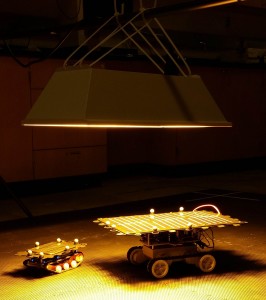 Ran Dai earns NSF CAREER award to design unmanned vehicles for long-duration, high-efficiency missions
Ran Dai earns NSF CAREER award to design unmanned vehicles for long-duration, high-efficiency missions
Using renewable energy to power aerial and ground vehicles could change the way we handle aspects of environmental monitoring, search and rescue missions, surveillance, and agricultural practices.
To navigate these sorts of dynamic environments, Ran Dai, an assistant professor in aerospace engineering and Black and Veatch Faculty Fellow, says a solar-powered robotic system offers a lot of promise.
“Operations that span a wide area need vehicles that are adaptable and have extended endurance,” Dai said. “We want harvest the energy that powers these missions from the environment instead of using limited, non-renewable fuel sources.”
During her first year at Iowa State, she and undergraduate research assistants manufactured the first prototype of a solar-powered ground vehicle. The vehicle is capable of designing an efficient path to harvest energy from the environment while simultaneously allocating its available power among electric components. The team also created an indoor solar simulator to have a static environment for evaluating the robot’s performance.

Now, Dai is moving forward with a second-generation robot, adding real-time power tracking to record the vehicle’s power intake and consumption, along with a solar-powered unmanned aerial vehicle.
Her work will be supported by a $500,000 National Science Foundation CAREER Award for the project “Solar-Powered Unmanned Aerial and Ground Vehicles for Long-Term Operation in Dynamic Environments.”
The biggest limiting factor to her project is, of course, weather, but she says having the robots create solar density images can help determine the best path to travel in a given area.
“Our algorithms can help the robot make decisions based on available solar energy,” Dai added. “But if it’s cloudy, the robot could go into sleep mode to conserve energy, resulting in a delay in completing a mission.”
She says those sorts of delays could be offset with cooperative, back-up vehicles that harvest energy while the other robots are doing work. When the working robots need to recharge, the second group could step in to realize a persistent operation.
Her award also supports the team’s plan to develop an open-source software program to help people interested in the technology create their own solar-powered robots.
“It’d be great to see people using this sort of technology to improve things in their home. For example, you could program the vehicle to water your plants. Using a solar panel, the robot can search for the sunniest spot and recharge so you wouldn’t have to worry about the robot running out of power,” Dai said.
She adds that the big picture is what drives her to move the project forward. “Not only can we help improve photovoltaic products through increase in demand, we can contribute to the country’s economic vitality, public health and security with these vehicles. I’m thankful to have the opportunity to advance this technology.”